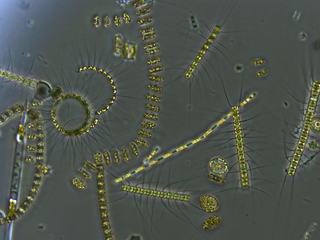
Zooplankton are the animal component of the planktonic community, having to consume other organisms to thrive. Plankton are aquatic organisms that are unable to swim effectively against currents. Consequently, they drift or are carried along by currents in the ocean, or by currents in seas, lakes or rivers.

Copepods are a group of small crustaceans found in nearly every freshwater and saltwater habitat. Some species are planktonic, some are benthic, a number of species have parasitic phases, and some continental species may live in limnoterrestrial habitats and other wet terrestrial places, such as swamps, under leaf fall in wet forests, bogs, springs, ephemeral ponds, puddles, damp moss, or water-filled recesses of plants (phytotelmata) such as bromeliads and pitcher plants. Many live underground in marine and freshwater caves, sinkholes, or stream beds. Copepods are sometimes used as biodiversity indicators.

Calanoida is an order of copepods, a group of arthropods commonly found as zooplankton. The order includes around 46 families with about 1800 species of both marine and freshwater copepods between them.

The butterfly perch is a marine species of ray-finned fish in the subfamily Anthiinae, part of the sea bass family Serranidae. This fish is found in the eastern Indian Ocean, and the southwestern Pacific Ocean, including the waters around southern Australia and New Zealand. It is sometimes known as the red perch.

Acartiidae is a family of calanoid copepods distinguishable by the rostral margin not being extended. They are epipelagic, planktonic animals, not being found below a depth of 500 metres (1,600 ft). There are over 100 described species distributed throughout the world's oceans, mainly in temperate areas.

Acartia is a genus of marine calanoid copepods. They are epipelagic, estuarine, zooplanktonic found throughout the oceans of the world, primarily in temperate regions.

Acartia clausi is a species of marine copepod belonging to the family Acartiidae. This species was previously thought to have a worldwide distribution but recent research has restricted its range to coastal regions of the north-eastern Atlantic Ocean as far north as Iceland, the Mediterranean Sea and the Black Sea, with specimens from other regions assigned to different species.
Acartia lefevreae is a species of copepod belonging to the family Acartiidae. This species was discovered when specimens previously identified as Acartia clausi were examined and found to belong to a separate species. Its range overlaps with that of A. clausi, being found in the western Mediterranean and the north east Atlantic as far north as the English Channel, but it tends to be found in more brackish habitats such as estuaries.
Acartia teclae is a species of copepod belonging to the family Acartiidae. This species was discovered when specimens previously identified as Acartia clausi were examined and found to belong to a separate species. This species appears to have a similar range to, and occupies similar brackish estuarine habitats as, Acartia lefevreae but differs in the absence of spines on the dorsal part of the posterior body segment (metasome).
Acartia omorii is a species of marine copepod belonging to the family Acartiidae. This species was discovered when specimens previously identified as Acartia clausi were examined and found to belong to a separate species. This species is found around the coast of Japan. It is similar to A. clausi but lacks the prominent spines on the dorsal part of the posterior body segment (metasome).
Acartia hudsonica is a species of marine copepod belonging to the family Acartiidae. Acartia hudsonica is a coastal, cold water species that can be found along the northwest Atlantic coast.
Acartia ensifera is a species of marine copepod belonging to the family Acartiidae. This is a slender copepod, around 0.8–0.9 mm (0.031–0.035 in) in length, with distinctively long caudal rami. It is found around the coasts of New Zealand.
Acartia simplex is a species of marine copepod belonging to the family Acartiidae. It is found in the waters near Australia and New Zealand.
Acartia jilletti is a species of marine copepod belonging to the family Acartiidae. This species has a total length of up to 1 mm. It is very similar to Acartia ensifera but the female can be distinguished by the shorter caudal rami and the male by the relative length of spines on the fifth pair of legs. This species has been recorded from scattered locations around the coast of New Zealand.
Syndinium is a cosmopolitan genus of parasitic dinoflagellates that infest and kill marine planktonic species of copepods and radiolarians. Syndinium belongs to order Syndiniales, a candidate for the uncultured group I and II marine alveolates. The lifecycle of Syndinium is not well understood beyond the parasitic and zoospore stages.

Lernaeocera branchialis, sometimes called cod worm, is a parasite of marine fish, found mainly in the North Atlantic. It is a marine copepod which starts life as a small pelagic crustacean larva. It is among the largest of copepods, ranging in size from 2 to 3 millimetres when it matures as a copepodid larva to more than 40 mm as a sessile adult.
Ellobiopsis is a genus of unicellular, ectoparasitic eukaryotes causing disease in crustaceans. This genus is widespread and has been found infecting copepods from both marine and freshwater ecosystems. parasitism has been seen to interfere with fertility in both sexes of copepods.
Acartia tonsa is a species of marine copepod in the family Acartiidae.

Janet Mary Grieve, also known as Janet Bradford-Grieve and Janet Bradford, is a New Zealand biological oceanographer, born in 1940. She is researcher emerita at the National Institute of Water and Atmospheric Research in Wellington. She has researched extensively on marine taxonomy and biological productivity. She was president of both the New Zealand Association of Scientists (1998–2000) and the World Association of Copepodologists (2008–11).






